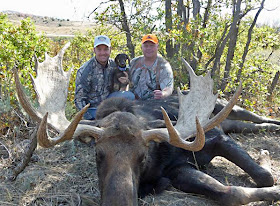This is a somewhat edited version of article that John wrote for Full Cry.
We are receiving some interesting feedback from folks who purchased our puppies last summer. I’d like to share some of it with you, but please don’t take this as an attempt to get puppy advertising on the cheap. We don’t have any puppies for sale.
The puppies we sold last summer were part of our project of conditioning pups at a very young age as a means of expanding their capacity to track later on. We used deer blood, deer liver drags and deer gland scents. I’ve written about this in a recent Full Cry article, “Nature and Nurture”, and I hope that our experiences will encourage some other breeders and owners of young puppies to try early conditioning. We’ll come back to the theory of puppy conditioning later. First, I want to get on with the stories, which are fun even if they’re not very “scientific”.
We sold a “conditioned” puppy at the age of 12 weeks to Justin Richins, an outfitter in Utah. Last August Justin flew all the way out from Salt Lake City to New York State to pick up Remy, his wirehaired puppy. Justin never told me that his friends thought he was nuts, but I suspect that something similar might have passed through their minds.
Remy was supposed to be “just a puppy”, but when Justin’s clients began to hunt this fall there came a need for a tracking dog. Puppy Remy was all Justin had. Within three weeks, Remy had found three elk in Utah, a Shiras moose in Wyoming… and an easy antelope that didn’t really need tracking. I guess that Justin was worried that Remy might get bored just tracking elk.
The three elk, and later the moose, were the big challenges. Now I really don’t understand why this worked so well. If Justin had consulted me in advance, I would have said “No, the pup is still too young for anything but short easy tracks.” One day Justin did call me on his cell in the middle of a track. “ We have tracked this wounded elk a half mile from the hit site”, he said, “and then we jumped him. This elk will go a couple hundred yards and then bed down . When Remy tracks up to him, he takes off again before we can see him in the thick stuff. We’ve gone ¾ of a mile. What should I do?” My answer was, “Give Remy a rest and a drink . You’ll get the elk if he keeps bedding like that.” And they did get the elk.
 |
| Remy was instrumental in recovering this record-sized moose |
 |
| Remy at the age of four months |
Experimenting with the early conditioning theory probably isn’t practical for the breeder who has a litter of coonhound pups and is holding down a fulltime job. It’s too time-consuming. For a retired person, with more time and a special need to develop pups to their maximum potential, it may make sense. Certainly, it’s not the only way to develop an outstanding dog, but it’s worth thinking about. For developing dogs to do a specific task, like tracking, it has promise.
Below is a video of Remy tracking a fresh deer liver drag when he was ten weeks old.


Seems like the feedback you are receiving speaks for itself. I know one thing--the early conditioning combined with your breeding program has certainly helped create some happy owners!
ReplyDelete